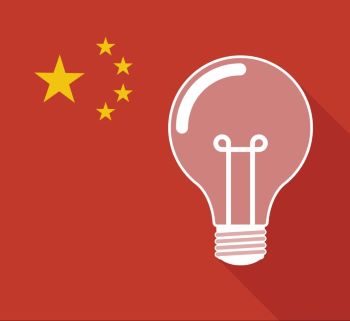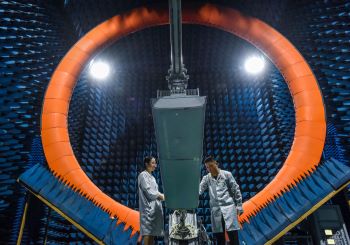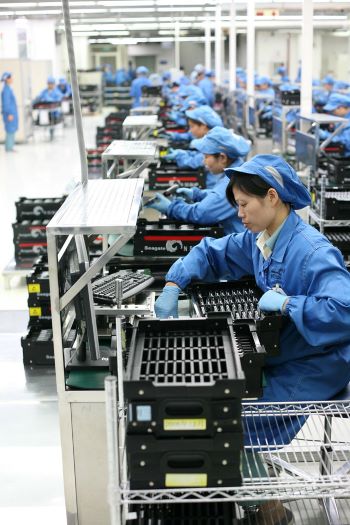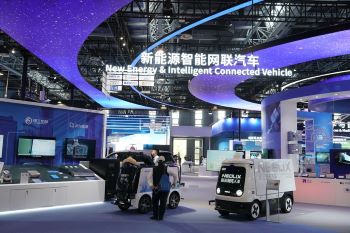China has become a global innovator that threatens to eclipse the U.S. and other Western countries: ITIF report
 China has much greater innovation capabilities in its universities and domestic companies than previously understood and now leads the U.S in many innovation indicators, according to a report by the Information Technology & Innovation Foundation (ITIF).
China has much greater innovation capabilities in its universities and domestic companies than previously understood and now leads the U.S in many innovation indicators, according to a report by the Information Technology & Innovation Foundation (ITIF).
China is no longer only a “copier” of Western countries’ innovations, but now leads or is on par with global leaders in innovating in commercial nuclear power and electric vehicles and batteries, says the report by the Washington-based science and technology policy think tank.
China lags behind in other key sectors, including robotics, biopharmaceuticals, chemicals and artificial intelligence. “But it is making rapid progress,” says the comprehensive report, China is Rapidly Becoming a Leading Innovator in Advanced Industries.
 “This rapid innovation progress stems from the Chinese Communist Party’s determined effort to dominate global markets in a host of advanced industries,” according to the report, by Robert D. Atkinson (photo at right), founder and president of ITIF and author of several books on technology and innovation.
“This rapid innovation progress stems from the Chinese Communist Party’s determined effort to dominate global markets in a host of advanced industries,” according to the report, by Robert D. Atkinson (photo at right), founder and president of ITIF and author of several books on technology and innovation.
The combination of low costs and growing innovation capability makes an increasing number of Chinese companies formidable global competitors, his report says.
“Overall, we find that, for the most part, while Chinese firms and industries are not as innovative as the global leaders in Western nations (defined as developed, democratic nations), they are catching up, in many cases at an extremely rapid pace – and the scale of their efforts is massive.”
These findings suggest it’s time to reject the often ideologically biased view that “China can’t innovate,” the report says.
The last decade has shown that China can be a globally competitive producer of technologically complex goods, including telecom equipment, machine tools, computers, solar panels, high-speed rail, ships, drones, satellites, heavy equipment and pharmaceuticals, according to the report.
“In all these industries, China has gained significant global market share – and it is making rapid strides in emerging industries such as robotics, AI, quantum computing and biotech.”
The ITIF’s Hamilton Index shows China led, in 2020, in seven of 10 advanced industries in global production, while the U.S. led in only three advanced industries.
China’s GDP is more or less equivalent to the U.S., China has significantly more exports, and its manufacturing sector is vastly larger.
But with all that strength, China still lacks high productivity and, for now, the ability to outcompete innovative leaders, Atkinson’s report says.
To date, much of China’s growth has come from copying the leaders and producing products that, while not as high quality, are priced more competitively. This has helped China gain market share, particularly in less-developed countries where price is a more important differentiating factor.
This is one reason why China has taken almost all the growth in advanced industries from nations outside the Organisation for Economic Development and Co-operation (OECD), the report notes.
However, if China can become an innovation leader, its development “poses a significant threat to Western nations and their firms because China will be able to combine quality, innovation and price.”
If China can compete across the board in an array of complex industries and produce new-to-the-world products, while also enjoying a significant cost advantage (Chinese labour costs around 25 to 30 percent of U.S. labour costs), that will be a major competitive threat to leading global innovation-based companies, and the economies that host them, according to the report.
“Also, without these companies producing in the U.S. and other advanced economies, these nations’ techno-economic power will decline relatively, as there is simply no way for domestic (and often smaller) firms to take up the slack when multinationals lose significant market share.”
 China achieving innovation parity would mean that the country would be much more self-sufficient in advanced industries and much less vulnerable to Western sanctions and other trade tools used in an attempt to discipline China.
China achieving innovation parity would mean that the country would be much more self-sufficient in advanced industries and much less vulnerable to Western sanctions and other trade tools used in an attempt to discipline China.
At the same time, achieving innovation parity would also boost Chinese military capabilities even more, as civil-military fusion becomes stronger, and weapons systems companies could rely on cutting-edge technologies across a range of industries.
“If China can become an innovative leader in robotics, electric vehicles, airplanes, semiconductors, drugs and more, it can dominate the global economy,” the report warns.
The report points out that the West could very well become what Australia, Canada, the U.K. and parts of Europe (e.g. Greece, Italy, Portugal and Spain) have already become: largely hollowed-out economies with little advanced manufacturing, a weak technology sector, and an economy propped up by tourism, finance, agriculture and natural resources.
China excels at production and is becoming good at innovation, not invention
Atkinson’s report makes the point that “innovation is not invention. It is not science. It is not necessarily entrepreneurship. It is bringing to market new products or services at scale.”
While that aspect of innovation is critical, so is the widespread diffusion and adoption of these products and services, the report says. Disruptive innovation is perhaps the most threatening to companies.
“Blackberry did not go out of business because the iPhone was a similar phone with a better physical keyboard; it went out of business because the iPhone and the business model that went along with it (including the app store) was disruptive.”
There are two key factors for innovation success, according to the report. One is talent, and the other is revenue.
“More money makes innovation vastly easier. Companies with more money can invest more in R&D. They can acquire talent and technology. They can pay their talent more. And they can achieve scale.”
 One of the main differences between the “Asian Tigers” (Japan, Singapore, South Korea and Taiwan) and China is that the Chinese market, and hence revenue, is vastly larger, the report says. Because China manages its market and limits foreign sales once its firms get to a certain scale, “Chinese firms are blessed with massive, largely secure market revenues, and this does not take into account massive government subsidies.”
One of the main differences between the “Asian Tigers” (Japan, Singapore, South Korea and Taiwan) and China is that the Chinese market, and hence revenue, is vastly larger, the report says. Because China manages its market and limits foreign sales once its firms get to a certain scale, “Chinese firms are blessed with massive, largely secure market revenues, and this does not take into account massive government subsidies.”
The World Intellectual Property Organization’s (WIPO) 2022 Global Innovation Index ranks China 11th most innovative in the world and states: “China stands out for producing innovations that are comparable to those of the high-income group.”
A 2021 report, The Great Tech Rivalry: China vs the U.S., from Harvard’s Belfer Center, argued that China has become a serious competitor in the foundational technologies of the 21st century: AI, 5G, quantum information science, semiconductors, biotechnology and green energy.
The report noted: “In some races, it [China] has already become No. 1. In others, on current trajectories, it will overtake the U.S. within the next decade.”
Indicators of China’s growing strength as an innovator
Some of the ITIF report’s findings indicating China’s growing strength as an innovator include:
- In 2011, China’s total number of researchers exceeded 1.3 million, almost 20 percent more than the 1.1 million researchers in the U.S.
- In 2011, China spent $246 billion on research, just 58 percent of the $427 billion spent by the U.S. that same year. However, 11 years later in 2022, China had crept much closer to the U.S., now spending $811 billion, or 88 percent of the $923 billion spent by America.
- In 2013, 658 of the top R&D-spending firms were located in the U.S. – almost six times more than the 93 firms located in China. By 2023, China had increased its top R&D firms sevenfold, with 679 firms making the list. In the U.S., 827 firms made the list.
- In 2012, about 330,000 scientific and technical articles were published in China, compared with more than 430,000 articles published in the U.S. that same year. By 2016, China had surpassed the U.S. Most recent data from 2022 shows that China continues to exceed the U.S., publishing almost 900,000 articles, more than the 457,000 published in the U.S.
- From 2013 through 2015, China had no universities in the top 100 of the Academic Ranking of World Universities, a list published by the Center for World-Class Universities, while the U.S. had over 50 universities each year. By 2023, China had increased its number of top universities to 11, while the U.S. had 38 universities in the top 100.
- In 2015, China saw about $53.2 billion in venture capital investment, 20 percent more than the $43 billion in VC investments in the U.S.. The difference in VC investment between China and the U.S. hit its peak in 2018, when China received $123.5 billion. The U.S. fundraised $71 billion that same year. As of 2023, the two countries each raised about $27 billion in VC fundraising.
- In 2010, China was granted just 3,303 patents, less than one percent of all patents awarded by the United States Patent and Trademark Office (USPTO) that year. Yet, by 2020, China’s patent grants in the U.S. increased to almost 27,000, or seven percent of all grants. China had the third-most patents granted by the USPTO in 2020, behind only the U.S. and Japan – evidence that, despite some questionable patents, China is publishing many quality patents.
- Between 2017 to 2023, China rapidly increased its number of global science and technology clusters (as ranked by the WIPO) from just six clusters in 2017 to 23 in 2023. At the same time, the U.S. stayed relatively stagnant in its number of clusters, with 22 clusters in 2017 and 21 clusters in 2023.
- As of April 2024, there were 1,453 unicorn companies worldwide (valued at $1 billion or more), with many concentrated in the science and technology sector. The U.S. accounts for most of the world’s unicorns at 48 percent, while China holds 23 percent.
- In 2024, the U.S. housed 171 of the top 500 supercomputers, or 34 percent of the most-powerful supercomputers in the world. China housed 80 supercomputers, or 16 percent, of the world’s top 500 supercomputers.
- In 2014, 46 of the top 100 innovating companies were located in the U.S., while zero were in China, according to Clarivate’s annual list of the world’s top 100 innovators. Over the decade, China has increased the number of companies labeled as top innovators, while the U.S. has seen a substantial number of firms fall from the list. As of 2024, five Chinese firms made Clarivate’s list of top innovators, while 17 U.S. firms received the title.
- China has become the leader in almost all the critical technologies covered by the Australian Strategic Policy Institute’s Critical Technology Tracker. The tracker focuses on how innovative countries are in foundational technologies such as energy, the environment, defense, nuclear, quantum computing and many other critical industries. In the most recent tracker report, China leads in 57 out of the 64 critical technologies from 2019 to 2023, up from just three out of 64 from 2003 to 2007. Comparatively, the U.S., which led in 60 technologies between 2003 to 2007, now leads in just seven.
Examples of China’s innovation accomplishments
 The ITIF’s report also provides several “select cases” of China’s innovation accomplishments, including:
The ITIF’s report also provides several “select cases” of China’s innovation accomplishments, including:
- China has landed a craft on the dark side of the Moon and returned samples.
- China became the world’s largest automobile producer in 2009 and is now also the world’s largest producer and exporter of electric vehicles (64 percent of global EV production in 2024). (Photo at right shows intelligent connected vehicles).
- The country has developed an innovative stealth fighter that also deploys drones.
- Chinese scientists have developed a novel solar panel technology involving up-conversion of infrared photons.
- China recently set the world record for the fastest hyperloop train.
- A Chinese government-backed consortium of 40 universities has deployed a 1.2 terabit-per-second network, the fastest in the world, and purportedly is two years ahead of the other nations working on the technology.
- China has developed and deployed the world’s largest sodium battery unit capable of powering 12,000 homes.
- China has tested a maglev train – a train suspended above its tracks via a magnetic field – that operates at speeds of 281 miles per hour.
- In 2024, a Chinese physicist became the first Chinese researcher to win the top U.S. physics prize.
- The country built and operates the largest and most highly automated seaport in the world.
- China has launched satellites with a powerful electric engine, and has launched robots on satellites that have the ability to hack apart other nations’ satellites in space.
When it comes to innovation by key Chinese industries, the ITIF report notes:
- China installed more industrial robots than the rest of the world combined in 2023.
- In 2013, the U.S. share of global chemicals industry R&D spending was 30 percent, while China’s was one percent. By 2022, Chinese chemical companies grew to 16.8 percent, with the U.S. share falling to 18.6 percent.
- China has more nuclear power plants under construction than the rest of the world combined.
- China will add more chipmaking capacity than the rest of the world combined in 2024, with 1 million more wafers a month than in 2023.
- Chinese clinical trials grew 146 percent from 1,040 in 2017 to 2,564 in 2021, the highest for any country.
U.S. needs a new model of innovation and “national power capitalism”
The ITIF for its report also randomly selected 44 Chinese firms for deeper analysis.
On a scale of 1 to 10, where 1 is completely a copier company with no real original innovation and 10 means the firm is moderately to significantly ahead of the global leading edge of innovation, the mean score for Chines firms was 6 – or lagging, perhaps two years behind, with some original innovation.
The ITIF’s analysis found that Chinese innovation was: ahead of the U.S. in nuclear power; at par in EVs and batteries; near in robotics, AI, quantum and display technology; and lagging in chemicals, machine tools, biopharmaceuticals and semiconductors.
 China’s economic, trade, and technology policy is all about gaining relative global power through advanced industry leadership, Atkinson notes in the report.
China’s economic, trade, and technology policy is all about gaining relative global power through advanced industry leadership, Atkinson notes in the report.
“The Chinese Communist Party, especially under President Xi Jinping’s leadership, is focused first and foremost on maximizing global techno-economic power, including through an array of predatory mercantilist policies whose principal focus is on growing China’s advanced economy at the expense of the rest of the global economy, especially Western technology leaders.”
In contrast, Atkinson says, America “now appears to be nothing more than warring factions and tribes, each one proclaiming their goodness and others’ villainy, and with neither side focused on international advanced industry competitiveness.”
“U.S. policy is focused on jobs; Chinese policy is focused on creating globally powerful firms,” the ITIF report says.
The American/Western linear model of innovation depends largely on good science, risk-taking entrepreneurs and global market access, according to the report.
But even with all the spending on research, there are not really all that many fundamental breakthroughs such as gene editing, quantum computing or deep learning AI models. Breakthroughs are rare. Scaling up and incremental innovation are not.
“The current model of U.S. invents [and] China produces at scale is no longer sustainable if America does not want a technologically hollowed out economy,” the report says.
Several ITIF reports have laid out a detailed agenda to ensure the U.S. and its Western allies don’t lose their techno-economic lead to China. In this new report, Atkinson offers five key proposals:
- Triple the Research and Experimentation Tax Credit. The Chinese R&D credit is already likely at least three times more generous than America’s, China’s R&D labor costs are less than half, and its R&D personnel costs are likely at least half of costs in the U.S. One of the simplest and easiest-to-administer steps Congress could take would be to triple the R&D tax credit for the Alternative Simplified Credit from 14 percent to 42 percent and allow expenditures on global standards setting to qualify.
- Establish five national industrial research institutes focused on key, dual-use industries and technologies, modeled after Taiwan’s Industrial Technology Research Institute, an industry-government advanced technology lab focused largely on IT technologies.
- Establish a “Competitiveness Advanced Research Projects Agency (ARPA–C) ”to co-invest with industry on research and application of key technologies needed for dual-use national security leadership in the commercial sector. Funded by year five with at least $20 billion per year, such an entity could be administered by the U.S. National Institute of Standards and Technology.
- Establish a national industrial development bank to provide low-interest patient capital for new domestic manufacturing investment.
- Institute a seven-year, 25-percent investment tax credit for all new machinery and capital equipment. America is “capital equipment lite;” China is not.
The U.S. needs to move from a science-based innovation system – with the view that scientific research is the foundation of national innovation success – to an industrial production-capabilities view that sees utilizing knowledge in products and service at scale as the key, Atkinson says.
The model he advocates is “national power capitalism” – based on the idea that the state plays a strong and conscious role to drive economic development.
National power capitalism is goal-oriented – like U.S. defense policy, the report says. “We need a robust biotech industry, chip industry, aerospace industry, AI industry, etc., and then to design and implement policies to achieve that.”
Atkinson argues that the U.S. should emulate many parts of the Chinese innovation system that would benefit the U.S. These elements include:
- China’s high levels of investment, rather than spending.
- the country’s overarching focus on winning in selected advanced industries.
- building up strong levels of domestic agglomeration.
- becoming much faster and “limiting the regulatory morass that in the United States has become reflexively ‘no.’”
- widespread support for innovation and progress.
- the Chinese government’s relatively deep understanding and embrace of science and technology policy for competitiveness.
If China can move to the frontier of global innovation – a destination all forces in China are pulling toward – the world economy and relative national power will be fundamentally transformed, the report warns.
Says Atkinson: “Unless U.S. techno-economic policy changes to embrace national power capitalism, it is less likely that the United States will be able to maintain a competitive position in a broad array of advanced industries against not only China but also other nations that play more by the rules but are still competing for global market share.”
R$
| Organizations: | |
| People: | |
| Topics: |
Events For Leaders in
Science, Tech, Innovation, and Policy
Discuss and learn from those in the know at our virtual and in-person events.
See Upcoming Events
You have 0 free articles remaining.
Don't miss out - start your free trial today.
Start your FREE trial Already a member? Log in
By using this website, you agree to our use of cookies. We use cookies to provide you with a great experience and to help our website run effectively in accordance with our Privacy Policy and Terms of Service.





.png)